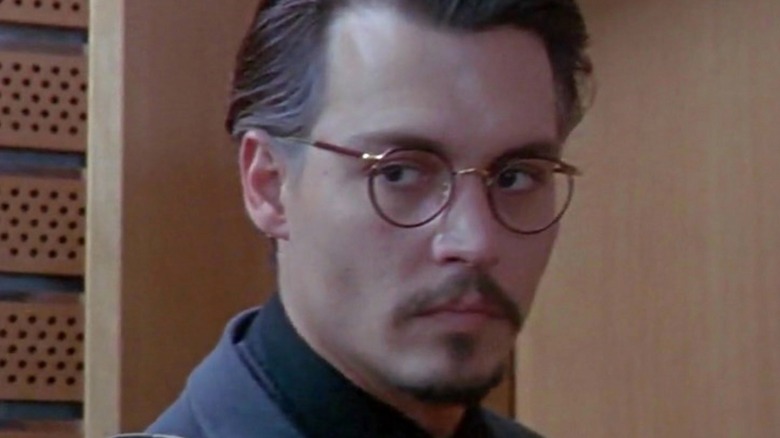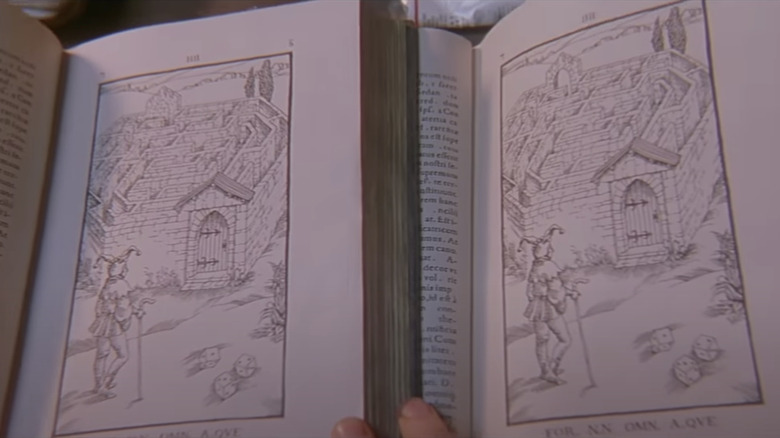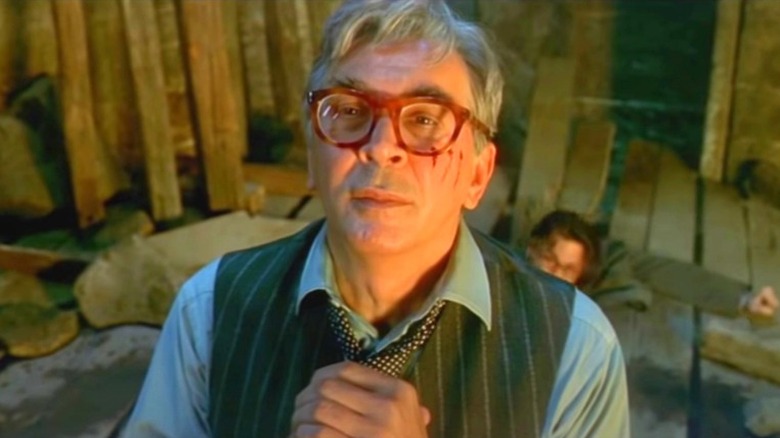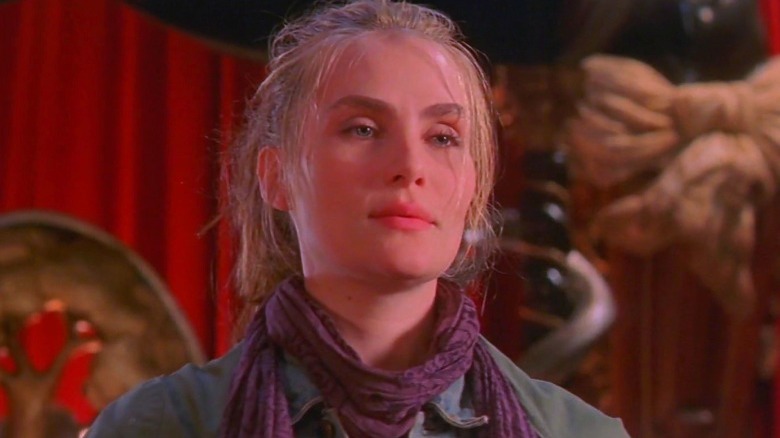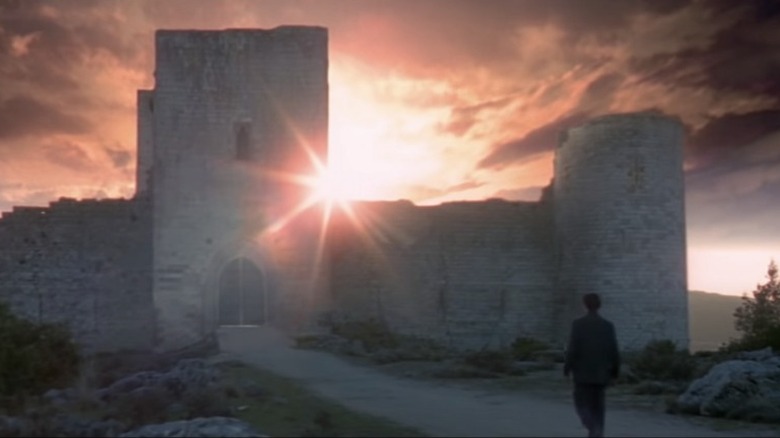The Ending Of The Ninth Gate Explained
From the mind of controversial director Roman Polanski, the supernatural thriller "The Ninth Gate" is a movie adapted from Arturo Perez-Reverte's 1993 novel "The Club Dumas." The 1999 film follows the main character Dean Corso, played by Johnny Depp, who is an antique book dealer who practices unscrupulous methods to get what he wants. His reputation soon gets him noticed, and Corso is hired by scholar Boris Balkan (Frank Langella) to authenticate his copy of "The Nine Gates of the Kingdom of Shadows," allegedly written by the Devil.
During Corso's hunt for answers, he becomes embroiled in a wide-reaching conspiracy, with a character only named the Girl (Emmanuelle Seigner) — who demonstrates a talent for the supernatural — as an ally. The movie can definitely be called strange and mysterious, but that is part of the joy of "The Ninth Gate." Nothing is spelled out for the audience, and like many films, it's all up for interpretation. But it's arguably the ending that makes "The Ninth Gate" truly memorable.
Corso discovers the dark meaning behind the engravings
A detective story at heart, "The Ninth Gate" kicks off with an investigation. Balkan enlists Corso's services because he is unsure if his copy of "The Nine Gates" is a forgery or not. With only two other copies in the world, Balkan is desperate to find out which book can actually summon the Devil. Though Corso is relatively dismissive in all matters of the supernatural, he accepts Balkan's money and goes on a European excursion to find out the truth.
One of the main mysteries surrounding the three books are the differing engravings found inside. Each book has the same number of images, but the pictures vary slightly from each other. When Corso compares the images, he finds that some of the engravings are marked LCF — an obvious allusion to Lucifer, another name for the Devil. However, when Corso investigates further, he finds that the engravings by LCF differ from book to book. So which book is the correct one?
They're all correct. When all of the LCF engravings from each book are combined, it shows the path to do the summoning. If Balkan's true desire is to summon Satan, the only way to do it would be to gather all the corresponding engravings. But the mystery continues. Even if someone does perform the ritual according to the marked engravings, does that confirm that the Devil is real?
The subject of the Devil is up for debate
If there is one thing that Corso is sure of, it's that many people believe in the Devil's power. At first, it doesn't seem as though the book dealer is among that population. Corso is painted as a pure skeptic whose only motivation is money. But as he investigates the truth behind "The Nine Gates," there is no denying that he witnesses some element of the supernatural. Along his travels, he teams up with the Girl, who exhibits abilities such as levitation and glowing eyes. But Corso continues to choose logic over the supernatural, and this all comes to a head when Balkan obtains all of the engravings required for the ritual.
Corso looks on in horror as Balkan becomes convinced that he finally has the power to do the summoning. Encased in a ring of fire, Balkan's arrogance gets the better of him. He touches the flames, certain he will not be burned. But after dousing himself in gasoline, he is proven wrong. He only realizes the ritual is a failure when he succumbs to the flames and Corso must put him out of his misery. But why does Balkan fail? Is he just not the chosen one, or is it all fake?
If the film were to end there, it would confirm Corso's suspicions: the Devil doesn't exist and all the people worshiping Lucifer are in the wrong. However, there are many factors of the ending of "The Ninth Gate" that throw this into question. In the final moments of the film, Corso learns a lot more.
Who even is the Girl?
Seigner's portrayal of the Girl is so mysterious that she never even gets a name. But despite this, she is in every pivotal moment of the film. Though Corso goes days without seeing her, she always shows up when she's needed. The Girl encourages Corso's pursuit of "The Nine Gates," though it is never entirely explained why she is so invested. But there are several clues that point to who the Girl is — or at the very least, who she represents.
The Girl is clearly not of this world. In addition to having no name, she miraculously comes to the rescue any time Corso needs her and she leads him to the correct engravings. In "The Club Dumas," this character goes by the name of Irene Adler, which is a clear allusion to Sir Arthur Conan Doyle's character in "Sherlock Holmes," a thief who, like the Girl, is manipulative and deceptive.
But the biggest clue to the Girl's identity is the final engraving. When Corso finds the last image, the picture is of a naked woman astride a multi-headed beast — and she looks exactly like the Girl. With the way the Girl is depicted in the movie, she is likely meant to represent the "Whore of Babylon," a complex figure featured in the Book of Revelation in the Bible, and her downfall mirrors the fall of Babylon (via The Gospel Coalition).
Only Corso finds the secret to summoning the Devil
For most of "The Ninth Gate," Corso's skepticism remains intact. His opinion is even substantiated when he witnesses Balkan's ritual fail. This seems like irrefutable evidence that none of the supernatural occurrences mean anything. But in the final moments of the film, Corso is proven wrong. There is one reason why Balkan's summoning failed, and it isn't because the Devil doesn't exist. Corso learns that one of the engravings Balkan works with is a forgery. Maybe Corso could go on living his life and forgot all about his experiences. But after everything he goes through, it isn't really an option for him. Corso's greed for money transitions into greed for knowledge and answers, and after coming this far, he intends to see it through.
Corso finds a separated engraving at one of the earlier locations he investigates. When he sees the image, it appears to convince Corso that everything he doesn't want to believe about the Devil is real. The engraving depicts the Girl in an image inscribed from the 1600s, which he sees as proof that this drawing is authentic. Corso has the piece that Balkan is missing all along, being guided by the Devil himself. Diverting from the book ending, Corso then arrives at a castle and travels through a gate filled with light, which many take to represent the titular "Ninth Gate."
The last scene is up for interpretation, with Corso striding towards the gate depicted in the drawing, but does he complete the ritual? The beauty of the film is that it is up to the viewer to decide if Corso's ultimate fate is to go down the path of darkness and sell his soul to Lucifer, or something else. Of course, just like Corso, the audience spends much of the movie skeptical of it all, and even after all this, "The Ninth Gate" leaves enough unanswered to allow viewers to keep wondering.
